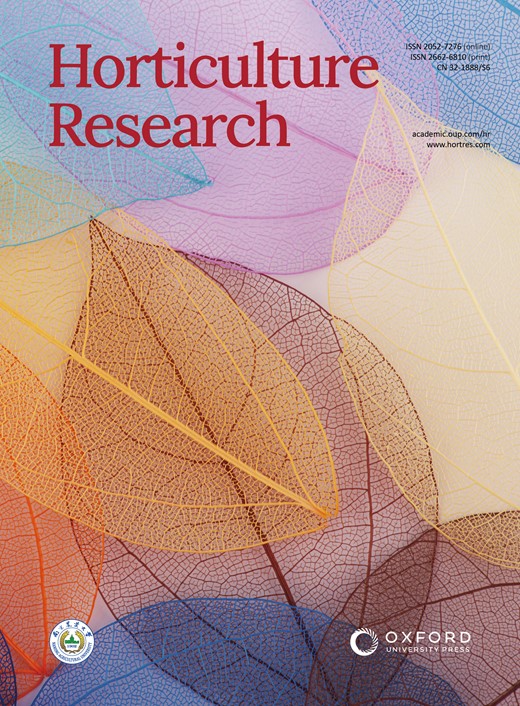对番茄花蕾的全基因组表达图谱显示,slercerf162 - slerf162模块与基础耐热性相关
IF 8.5
1区 农林科学
Q1 Agricultural and Biological Sciences
引用次数: 0
摘要
高温损害花粉活力,减少坐果,最终影响作物产量。了解参与热胁迫(HS)反应的遗传成分对于开发气候适应型作物品种至关重要。然而,番茄花粉发育过程中热胁迫反应的调控机制尚不清楚。在本研究中,我们确定了小孢子母细胞阶段是番茄花粉发育中最热敏感的阶段。此外,我们生成了HS下番茄花蕾的综合RNA表达谱,包括8,051个mrna, 5,738个lncrna, 62个circrna和24个mirna。对这些rna的比较分析揭示了三个不同的反应阶段,早期、晚期和双重,并能够识别包含编码和非编码转录本的共表达模块。其中,SlERF162被鉴定为促进花粉耐热性的关键调控基因。我们进一步鉴定了lncRNA tcon_00023929(指定为SllncERF162)作为SlERF162表达的正调节因子。SlERF162和SllncERF162都对保持HS下花粉活力有贡献。另外的实验表明,slercerf162 - slerf162调节模块通过直接靶向和激活热响应基因SlHsfB1和SlsHSP来增强基础耐热性。总的来说,本研究提供了HS下rna的高分辨率表达图谱,并揭示了一个新的非编码rna介导的调控网络,该网络在番茄花粉发育过程中促进了耐热性。本文章由计算机程序翻译,如有差异,请以英文原文为准。
Genome-wide expression atlas of tomato flower buds revealed the SllncERF162-SlERF162 module associated with basal thermotolerance
High temperatures impair pollen viability and reduce fruit set, ultimately affecting the yield of crops. Understanding the genetic components involved in the heat stress (HS) response is essential for developing climate-resilient crop varieties. However, the regulatory mechanisms governing heat stress responses during pollen development in tomato (Solanum lycopersicum) remain unexplored. In this study, we identified the microspore mother cell stage as the most heat-sensitive phase in tomato pollen development. Furthermore, we generated a comprehensive RNA expression profile of tomato flower buds under HS, encompassing 8,051 mRNAs, 5,738 lncRNAs, 62 circRNAs, and 24 miRNAs. Comparative analysis of these RNAs revealed three distinct response phases, early, late, and dual, and enabled the identification of co-expression modules comprising both coding and noncoding transcripts. Among these, SlERF162 was identified as a key regulatory gene that promotes pollen thermotolerance. We further identified the lncRNA TCONS_00023929 (designated SllncERF162) as a positive regulator of SlERF162 expression. Both SlERF162 and SllncERF162 contributed to maintaining pollen viability under HS. Additional experiments demonstrated that the SllncERF162–SlERF162 regulatory module enhances basal thermotolerance by directly targeting and activating the heat-responsive genes SlHsfB1 and SlsHSP. Overall, this study provides a high-resolution expression atlas of RNAs under HS and uncovers a novel noncoding RNA-mediated regulatory network that promotes thermotolerance during tomato pollen development.
求助全文
通过发布文献求助,成功后即可免费获取论文全文。
去求助
来源期刊

Horticulture Research
Biochemistry, Genetics and Molecular Biology-Biochemistry
CiteScore
11.20
自引率
6.90%
发文量
367
审稿时长
20 weeks
期刊介绍:
Horticulture Research, an open access journal affiliated with Nanjing Agricultural University, has achieved the prestigious ranking of number one in the Horticulture category of the Journal Citation Reports ™ from Clarivate, 2022. As a leading publication in the field, the journal is dedicated to disseminating original research articles, comprehensive reviews, insightful perspectives, thought-provoking comments, and valuable correspondence articles and letters to the editor. Its scope encompasses all vital aspects of horticultural plants and disciplines, such as biotechnology, breeding, cellular and molecular biology, evolution, genetics, inter-species interactions, physiology, and the origination and domestication of crops.
 求助内容:
求助内容: 应助结果提醒方式:
应助结果提醒方式:


